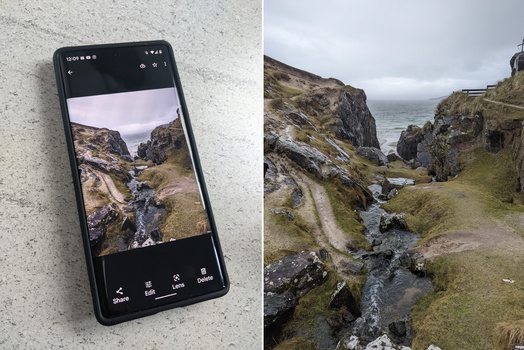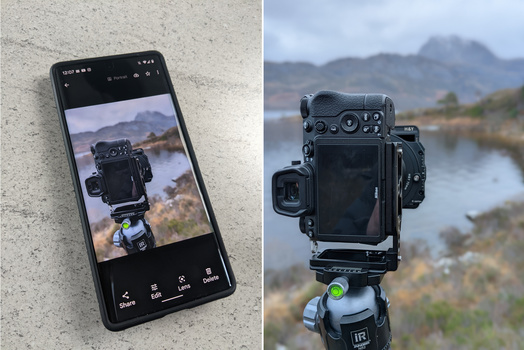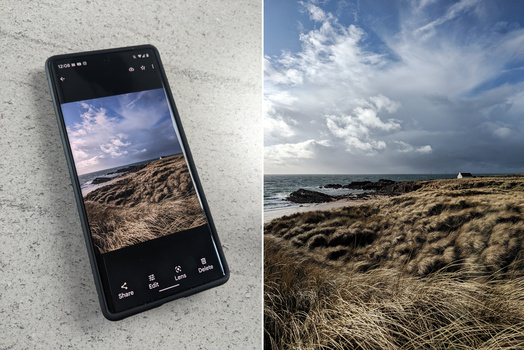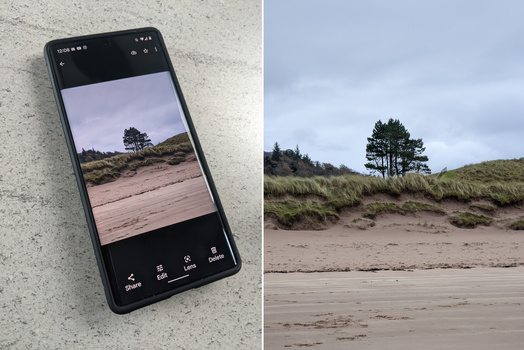Sometimes the best camera is the one you have with you and at times it's not your DSLR or mirrorless one. This is difficult because there are pros and cons to both options. If you have a mobile phone with you, then that can be the best option. However, if you need a more professional or reliable camera, then your DSLR or mirrorless will of course be the better choice.
There are moments when you can't use your professional camera though and it's in these times that we normally reach for our mobile phones. The pros to using a mobile phone camera are that you can take photos quickly and without much hassle, and ultimately, it depends on what is most important to you and what will work best for the specific situation.
For myself, I was a loyal Samsung user. I thought the images and the spec of the camera were ok considering it was a mobile phone. That was until I wanted to take a photograph that included the sky; then it seriously let me down. Although the images were not terrible, they lacked detail and the vibrancy was out of this world. To the point where I actually thought that Samsung had created a whole new color gamut that they were trying to unleash on the world. So I began to use my phone less and less to capture the handy shots, the moments, shall we call them. The shots where you decide to capture a scene or a memory quickly instead of using your camera.
Memory Over Quality?
It does really depends on the situation and what you are looking for in a photograph. For example, if capturing moments quickly with your phone is more important to you than having high-quality images, then using your mobile phone might be a better option. Conversely, if you care primarily about quality over speed and want to use the best camera possible — even if that means bringing along a DSLR or mirrorless camera — then that's entirely up to you. For myself, however, I wanted the best of both worlds.
I wanted to be able to capture these moments with my mobile phone and not be concerned about whether the person or scene had a sky in it, or had to really suppress the saturation to get any form of decent snapshot. I live in Scotland and we mainly get gray skies, but oh no, not with a Samsung. With the Samsung, the resulting images looked as if gray skies had a vibrant blue or teal, and we would often joke about the vivid and nuclear color reproduction.
So, I reached for my mobile phone less and less. It became its primary function again and not a handy carry all the time camera. I love the mobile phone for that; I can take snapshots and capture memories wherever I am without worrying too much about the overall quality, as it's nice to see and remember these moments visually.
The last time I used my Samsung for a photograph was about 3 weeks ago when on a workshop in Glencoe. The usual gray moody skies and it was raining, of course, I thought the shot would come out ok, more fool me. The water and mountains were never that color.
So what changed? Well, I upgraded my phone to a Google Pixel 6 Pro and that's when things really started to change. The detail in the images was fantastic for a mobile phone camera and it truly showed how versatile a good mobile phone camera can be. Because of this, I haven't hesitated to reach for my mobile phone so far in any situation and I love that I can be spontaneous and just snap away. But is this really photography? to be honest it doesn't really matter? What's important is that I'm capturing memories and moments that matter to me, no camera required.
Camera Specs
When I purchase a phone I honestly buy it for the camera, the best tool for the job so to speak. And although you may be an iPhone user or any other of the brands, the camera in the Pixel 6 pro is the best camera for me, and what I need from it. The rear camera contains a
- 50 MP Octa PD Quad Bayer wide camera, with an 82° field of view.
- 48 MP telephoto camera, with a 23.5° field of view
- 12 MP ultrawide camera, with a 114° field of view
The front camera is 11.1mp with a 94° ultrawide field of view, but I'm not into selfies so this one is not so important for me, anyway. So you can see that the specs are quite decent in today's mobile phone camera market. Although the rear camera sits proud of the housing this actually, in my opinion, helps with the use of the phone when typing or flipping through images as it doesn't have that awkward rolling when the camera lens is offset.
Camera Functions
Using the camera is fairly straightforward as well and we are all more than used to that by now. In its simplest form, you can just snap away or you can choose to focus on a point. When doing this another three sliders appear; temperature, contrast, and brightness. These do what they say on the tin without any adverse effects on your image, allowing you to control your final output.
Other functions of the camera include Night sight, Motion, Portrait, Video, Panorama, and Photosphere. As yet I've only experimented with night sight and motion (long exposure) and the results have been good for a mobile phone. Most of the options mentioned also allow for the zoom function to activate up to 20 times zoom, except for the portrait mode which is only 2 times. I would attach the phone to a tripod if considering a night sky hot at that range as we shake too much.
Currently, there is no macro mode but I do read it's in the pipeline for a future update, so time will tell how that performs. For now, though it snaps away ok.
So how does it perform for what I'm after?
Google Pixel 6 Pro for Landscape
To start with I'm not going to say that you should be shooting landscapes with a mobile phone, it's not unheard of, but for myself, that's what my camera is for. However, I was really impressed with the detail and clarity that the Pixel 6 Pro delivered when shooting landscapes. I love that you can get some great abstract images without having to reach for your camera, something which is very liberating in your photography workflow.
All the images in this article are straight from the phone, with no editing, so that you can see the images as they are straight from the camera without the post-processing that's always included in the adverts. The mobile phone is also able to capture lush greenery and wet surfaces incredibly well. It also has a long exposure feature which is fun to use for capturing waterfalls or night shots. Although this may seem quite gimmicky, if you think about it this is just a mobile phone and I did enjoy seeing the results it produced. Not quite what I expected but good enough to make me smile and that I had made the right decision in switching phones.
Apart from the gathering of memories, I use the mobile phone to check the composition of my shots before setting up the tripod and camera, as this is much quicker and easier, and I'm sure most if not all of you do the same. Now that I can include the sky in the setup of the shot I'm more than happy.
The 20 times zoom feature also surprised me when it came to the quality of such a small sensor. Meaning yet again I can inspect a telephoto composition without breaking out the lens. It's a useful feature but with its limitations, with that one being user shake. Imagine trying to shoot with a 100-400mm lens at 400mm, arms outstretched, and viewing with the scene via the LCD screen; you get the idea. The best way I found is to support it in some fashion, a rock, a fence post, anything just to get the view.
The images of the building below definitely highlighted the shake when trying to capture 20 x zoom, but that was to be expected at such close proximity. The images were captured at 2x,4x, and 20 x zoom.
Editing on the Phone
With the choice of so many different editing apps available, sometimes choosing the one that suits your workflow for mobile editing, or perhaps snapshot editing can be a little overwhelming. As an Adobe subscriber, I have Lightroom mobile on my phone as well as the Snapseed and Lens Distortion apps, all of which I use frequently, with the former being the main one. The Google Pixel 6 Pro comes with, as all phones do, a built-in editor, which produces some neat results without too much effort. You can't use masks like the above apps but it does work well for tweaking your images. There is even a magic eraser tool which again works well considering this editor comes with the phone.
What I Liked
The ease with which you can use the camera and its functions. No longer do I need to go into the pro mode to capture a half-decent mobile phone shot. The fun of the long exposure images. Selfishly, I'll include skies in this; I can shoot skies again. The built-in editor with its array of tools and presets. The haptic response level when using the camera.
What I Didn't Like
So far for the camera, I haven't found anything that has made me question my decision of swapping from Samsung. In fact, I wish I had swapped earlier, as perhaps I would have captured more memories
Should You Consider The Pixel 6 Pro?
Should you consider the Google Pixel 6 Pro if you're considering shooting landscapes with your mobile phone? well, the Pixel 6 Pro is a great option and delivers stunning detail and clarity and not just for landscapes. Although 20x zoom may not seem like a lot, it can be quite useful for capturing small details or when you want to get closer to your subject. The long exposure feature is also helpful for capturing waterfalls and night shots. The functionality of the camera is quite straightforward and you have the option of capturing both .jpg and raw files. All of this and more makes the Google Pixel 6 Pro a great option for quickly capturing landscapes, memories, and other photos.
If you're passionate about taking your photography to the next level but aren't sure where to dive in, check out the Well-Rounded Photographer tutorial where you can learn eight different genres of photography in one place. If you purchase it now, or any of our other tutorials, you can save a 15% by using "ARTICLE" at checkout.

















I got one of these recently. Seems like a pretty real step up from the Pixel 3 I replaced. In saying that, not a huge fan of the new some of the non-camera things; I miss the finger sign in being on the back, I don't like the large strip of cameras on the back that could have been less intrusive, and don't like the UI navigation not having an actual back button.
The UI as it's quite different from the Samsung, so still getting there with the navigation through the phone itself. Camera makes up for that though. Thanks for reading Ali
You can get the three bottom icons back, it needs to be changed in the system settings (system - gestures, system navigation - 3 button navigation).
I managed to get some decent shots of last year's Lunar eclipse in Brunei, Pixel 4A put on my travel tripod. Other handheld shots turned out great as well (cityscapes with Saturn in the background.
I have the normal 6 and yeah, I was going to say this about the back button. It's still there, you just gotta enable it. Honestly, I don't miss it at all. Swiping from the side is much easier, especially given the screen size.
And I'll be the second one in the line.
Ot at least, if we could get a global version of the Japanese Sharp/Leica phone...
Computational photography has made huge progress lately but not the sensors and optics...
Is this a paid ad ?
I doubt it, it is truly a fantastic phone and a great creative asset to photographers- when the big camera isn't with you that is.
No not a paid as Rex, just a personal opinion. Thanks for reading.
Hi Gary, have you been shooting in RAW for the scenes that you'd like the flexibility to process in post, or do you just shoot in the default JPG mode?
I also have a 6 Pro, but have not bothered to shoot in raw so far. Unlike when shooting with my Sony A73 ofcourse.
Hi Hameed, so far I've just been shooting in jpg although I am going to be shooting raw to see how far it can be processed. Be interesting to see the results. Thanks for reading.
I ❤️ the Pixels! But I got an S21 Ultra and I am hooked on all those cameras now. Both are amazing devices, with considerable strengths for when you just don't feel like carrying your gear.
I do love the ease of use that comes with them for the quick shots. Don't know if I have the courage to shoot solely with a mobile phone but might be an interesting challenge to find out the results
What I have been prone to doing lately is using a lens on the FF camera that gives the same FOV as the main shooter on the mobile phone, then taking two sets of photos to do a comparison. This reminds me that each device excels at certain things. It also leaves me longing for things like aperture control on the mobile phone and more amazing computational photography on the FF camera. I just traded up to a Samsung S22 Ultra from the S21 Ultra so it is a very capable and excellent device and is even more amazing with computational photography. And the Sony FF has some incredible strengths of its own that physics and purity of imaging can't be beat. Anyway, it is a real learning experience comparing these side-by-side. Thanks for the discussion, Gary!
My favorite thing about the Pixel is it forces Apple to play catch up. I don't know if Apple would be doing automatic stacking or would have anything close to Night Mode if the Pixel hadn't forced them into it. Now it Apple would only add astrophotography capabilities to bring it in line with the Pixel 3 I'd be really happy.
Let's wait for the new 2022 sensor. I really hope the algoritms will be modified to avoid this awful musshy skin texture...
What i don't like:
-photographing on a phone
-editing on a phone
Tried it in store, and such a great camera experience even there.